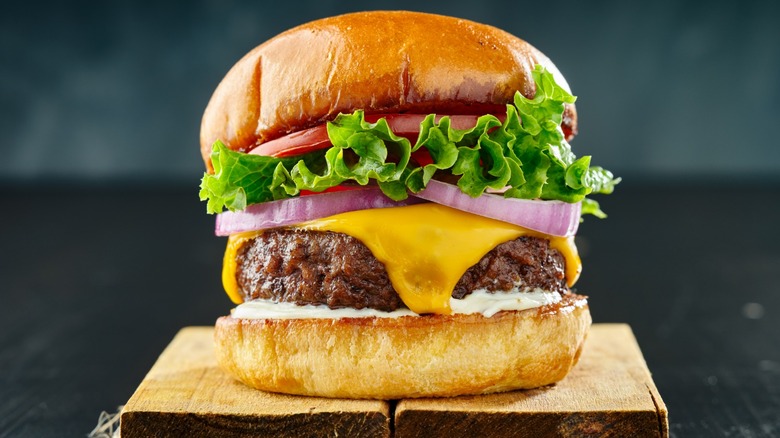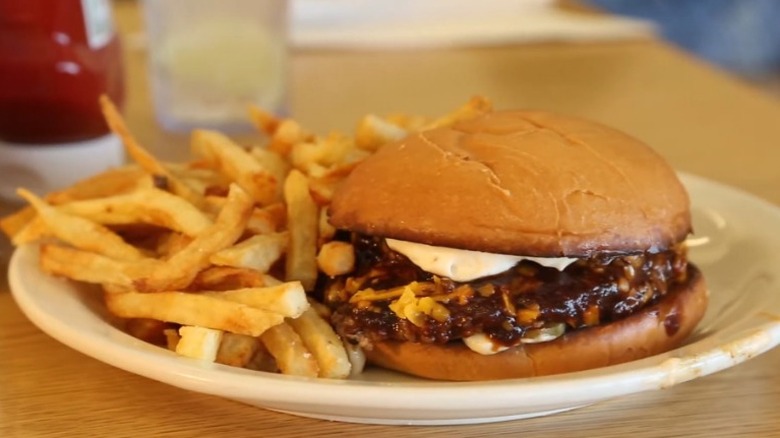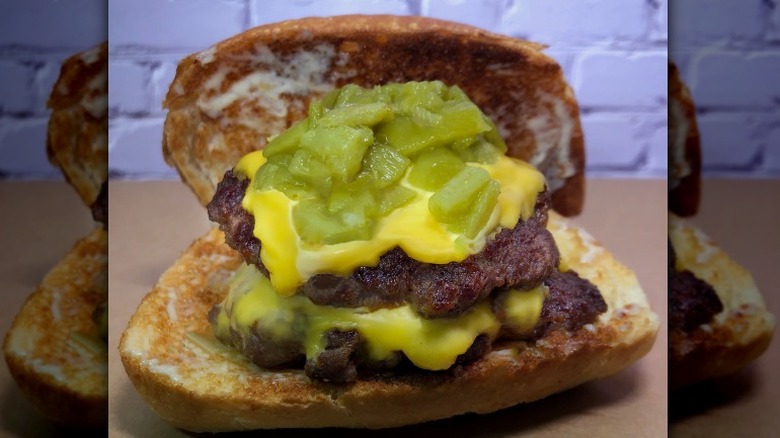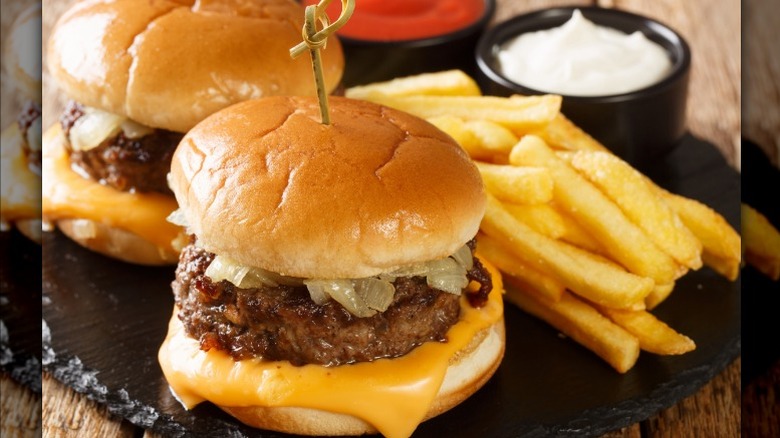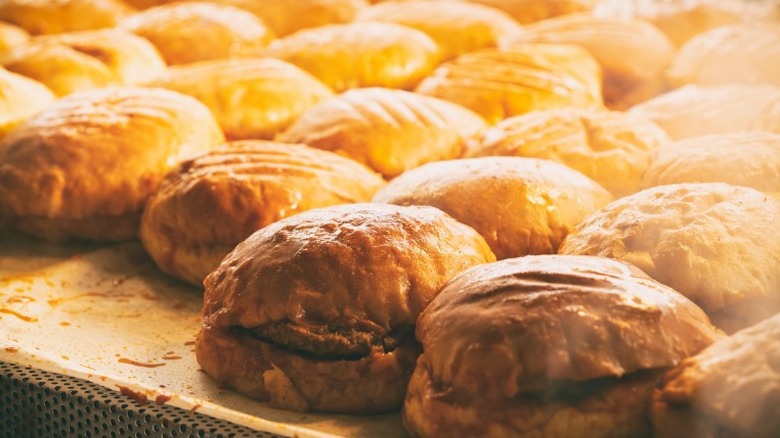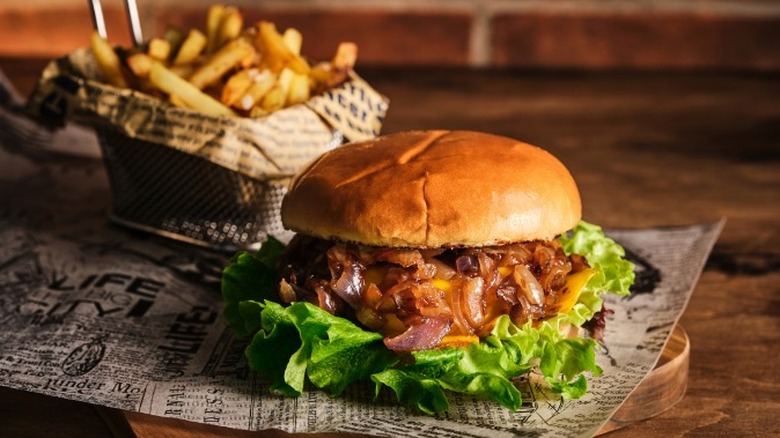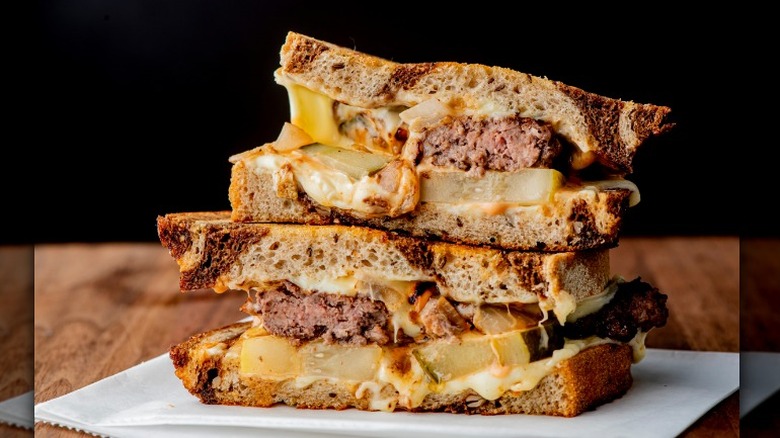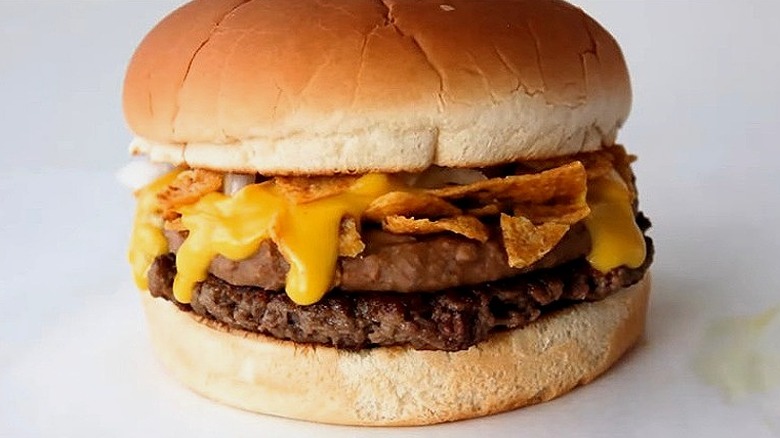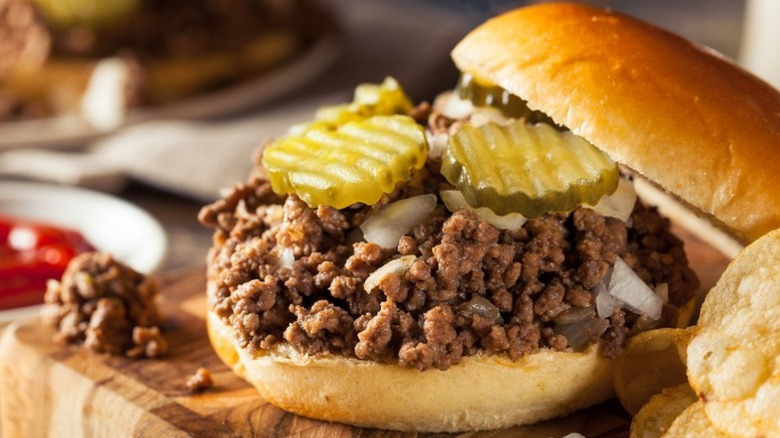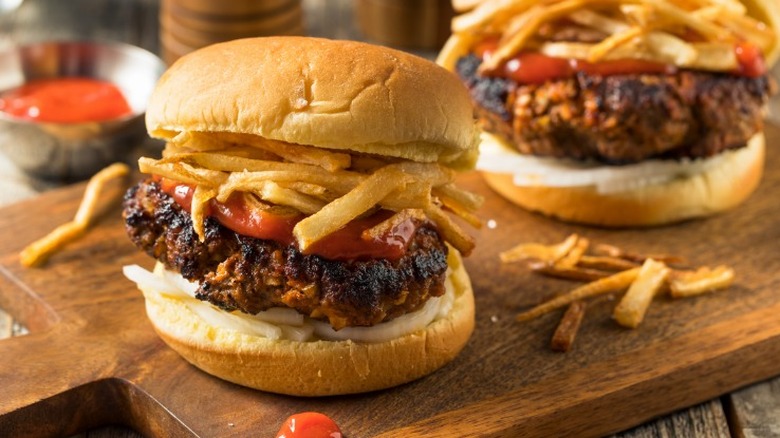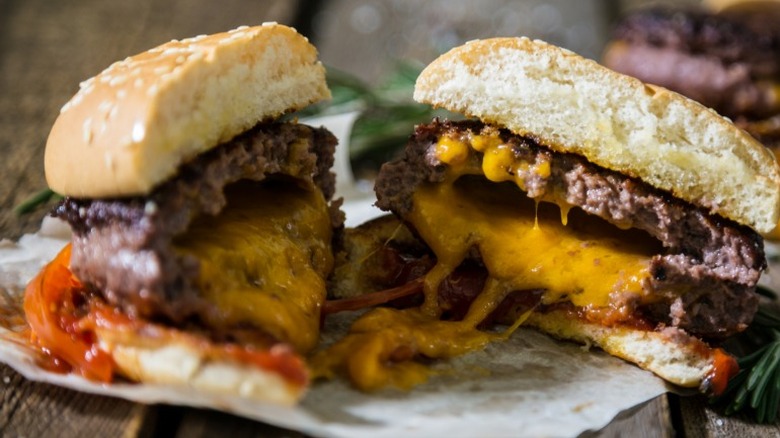10 Regional Burger Styles You Need To Know About
There is nothing quite like a well-prepared burger. Whether it comes from your backyard or a Michelin-starred restaurant, a good burger is a thing to savor. In addition to being delicious, hamburgers are also versatile. You can add some variety to your burger through your choice of sauce. Mayonnaise, ketchup, or mustard are some of the many options. You can even add more interesting toppings such as sautéed mushrooms or bacon.
Fast food chains like McDonald's are famous for their burgers, but these recipes are generally too broad to represent any particular region of the United States. However, there are dozens of regional burger varieties in America. These dishes originate from various places, from diners to speakeasies during Prohibition. Many of these dishes are now known on a much wider scale, such as throughout the country, or even the world. Here are 10 regional burger styles you need to know about.
1. Theta burger - Oklahoma
The Theta burger's origin story begins in Norman, Oklahoma —a college town known for the University of Oklahoma. In the 1930s, Norman had a restaurant called Town Tavern. Around this time, the business became popular with local students involved in campus Greek life, including those in a sorority called Kappa Alpha Theta, or simply "Theta." Students were particularly fond of Town Tavern's special burger.
This burger consisted of meat, mayonnaise, pickles, cheese, and a condiment called hickory sauce. This buttery spread was a big part of what made Town Tavern unique, and what kept students coming back for more. Hickory sauce is a type of barbecue sauce that has hickory smoke flavoring added to it. The burger was also unique for using shredded or grated cheese instead of slices. This order was so popular with college students that it became known as the "Theta burger." Its recipe remains popular today, especially in Oklahoma.
2. Green chile burger - New Mexico
New Mexico is known for its chiles. Its famous Hatch green chiles get their name from the town of Hatch, located in New Mexico's Hatch Valley. These chiles are an important part of the state's food culture. Because of that, they are found in all kinds of local recipes. It comes as no surprise, then, that Hatch green chiles are also used in New Mexico's burgers. This regional burger is referred to as the green chile cheeseburger.
One popular story says that the green chile burger originated at a San Antonio, New Mexico restaurant called the Owl Bar and Cafe, which opened in 1945. During a particularly busy spell at the restaurant, the kitchen ran out of clean dishes. At the time, cheeseburgers were served with a bowl of green chiles on the side. But since there weren't enough dishes for the green chiles, the cook put them directly on the burger. The recipe proved to be popular with customers.
In addition to the Owl Bar and Cafe, a few other New Mexico businesses — such as Buckhorn Tavern and the chain Lotaburger — claim to have invented the green chile cheeseburger. Whoever invented it, the burger is an undeniable hit. These chiles have a smokey kick to them that imparts a classically Southwestern taste to the burger.
3. Butter burger - Wisconsin
The Wisconsin butter burger is a standard burger. However, the patty receives an extra pad of butter as soon as it leaves the grill, creating something extremely decadent.
This food is often linked to Culver's, a national restaurant chain that got its start in Sauk City, Wisconsin. However, Culver's wasn't founded until the 1980s. There were a few other businesses serving butter burgers long before this: Solly's Grille in Glendale, Wisconsin, and Kroll's in Green Bay, Wisconsin. Both of these businesses have been around since the 1930s, making them half a century older than Culver's.
Aside from the additional serving of butter applied to the meat, this is a pretty standard burger. Solly's Grille makes its burger with beef, butter, and stewed onions. Kroll's makes its burger with ketchup, onions, pickles, and butter. For health reasons, it might not be the best idea to eat this burger regularly, but this regional delicacy is a must if you're ever in town for a Green Bay Packers game.
4. Steamed cheeseburger - Connecticut
Grilling is probably the most common method of burger preparation. Pan-frying is maybe the second-most popular method. But Connecticut residents like to do things differently. The state's famous steamed cheeseburger is an example of this.
This burger is often linked to Jack's Lunch, a restaurant that opened up in Middletown, Connecticut during the 1920s. Many believe that Jack's Lunch was the first to steam a cheeseburger. This restaurant is no longer open. However, another pioneer of the Connecticut steamed cheeseburger, Ted's Restaurant, is still open today. This eatery is located in Meriden, Connecticut.
You may ask yourself, why on Earth would anyone want to steam a cheeseburger? But there are good reasons for doing so. The resulting burger infuses the meat with other ingredients. It also helps the patty retain moisture during cooking. This makes it a lean burger that isn't dry, a difficult feat to pull off.
5. Fried onion burger - Oklahoma
The Oklahoma fried onion burger was created out of necessity during one of the most trying times in American history: the Great Depression. This period wreaked widespread havoc. During a series of environmental disasters known as the Dust Bowl — events that coincided with the Great Depression — Oklahoma's agriculture was hit hard. Struggling local cooks were forced to stretch their resources. Their solution was adding a substantial amount of fried onions to their beef burgers. People seemed to like the taste of the onion burger. On the other hand, the hungry patrons may have simply liked the appearance of a burger with larger proportions on their plate. Either way, the recipe stuck.
Maybe the best part about this regional burger is that you don't need to go to Oklahoma to get it. You can easily make this recipe at home. Just make sure to slice your onions extra thin and add a generous helping of them. Also, this burger is usually made with cheese. Popular options include cheddar or American.
6. Patty melt - California
Sometimes, a regional specialty becomes so popular that it spreads worldwide. Such is the case with the patty melt. This local burger recipe got its start in Los Angeles, California. During the 1950s, L.A. restaurant owner Tiny Naylor placed the patty melt on his menu. Since it was made with sandwich bread instead of hamburger buns, this beef-filled creation immediately stood out. The patty melt has remained popular over the years, becoming a staple menu item at diner-style restaurants.
A patty melt consists of ground beef, rye bread, onions, and cheese. This recipe, unlike most classic burger recipes, is known for using Swiss cheese instead of cheddar or American. However, you can also use these dairy options in your own patty melt. To make, ground beef is cooked into patties roughly the size of a slice of rye bread. Then, cooked onions, cheese, and a patty are placed between two slices of bread. Next, those pieces of bread are buttered. Finally, the whole thing returns to the pan, where it is cooked once again, allowing the cheese to melt and the bread to crisp.
7. Bean burger - Texas
This regional burger style was born in San Antonio, a city well-known for its Tex-Mex food. Since the cuisine is built around the fusion of American and Mexican food cultures, it makes sense that a burger with refried beans on it would come from this part of the country.
The bean burger's story is said to begin at a Texan eatery called Sill's Snack Shop. The original recipe consisted of a ground beef patty, refried beans, Fritos chips, and Cheez Whiz. This new invention was a hit with locals and remains so today. Now, you can find a San Antonio bean burger — or a Texan bean burger, as it is also called — on several menus in the city. You can even find recipes for this regional burger style online. In newer variations, changes to this dish are sometimes made. Refried beans are swapped for black beans, or tortilla chips are used in the place of Fritos.
8. Loose meat sandwich - Iowa
The origins of the loose meat sandwich are murky, but it is generally thought to have come from Sioux City, Iowa. It is commonly associated with the Maid-Rite restaurant chain, as well as a local eatery called Ye Olde Tavern. Today, Ye Olde Tavern has closed, but Maid-Rite continues to serve loose meat sandwiches.
If you are wondering why a sandwich is on a list of burgers, there is a good reason: the name is misleading. The Iowa loose meat sandwich uses similar ingredients to a traditional burger. It even uses buns, not sandwich bread.
However, this recipe is unique because the ground beef is cooked as-is. It is not formed into patties. This may sound like a sloppy joe, but since there is no tomato sauce, there's nothing to bind the burger meat together. You end up with crumbly bits of beef. Once cooked, you have the option to dress the burger with ketchup, mustard, and pickles.
9. Frita Cubana - Florida
Heat, humidity, and Cuban food are all classic Florida things. Delicacies such as the Cubano, also known as the Cuban sandwich, are popular in the state. This traditional dish is made with ham, pork, pickles, mustard, and Swiss cheese. It also helped pave the way for a regional burger style called the frita Cubana. Both were historically served as street food, but can now be found on sit-down restaurant menus.
The frita Cubana is a Florida specialty. Its pork and ground beef patty is topped with a delicious pile of shoestring french fries. Yes, there are french fries inside the actual burger. In addition to this element, the frita Cubana is well-known for its sauce. This element consists of ketchup, vinegar, hot sauce, spices, and seasonings. Sometimes, grated garlic and onions are cooked into the burger patties, making the meat itself all the more flavorful. But the combination of it all is really something.
10. Juicy Lucy - Minnesota
Minnesota has its own twist on the burger: the Juicy Lucy. The recipe is said to have originated during the Prohibition era, at a speakeasy called the 5-8 Club. This establishment opened its doors in Minneapolis, Minnesota in 1928. While they were devoted to offering a place to drink alcohol, the 5-8 Club also wanted to serve food. From this desire, the Juicy Lucy was born.
Although it is made with normal cheeseburger components, how the Juicy Lucy is prepared is unique. Instead of putting a piece of cheese on top of the burger patty, the cheese gets folded into the center of the meat. American cheese is always used. With this recipe, there is less flexibility surrounding the choice of dairy. You can easily make this at home, but the original 5-8 Club is still open and worth a try when visiting the Twin Cities.
